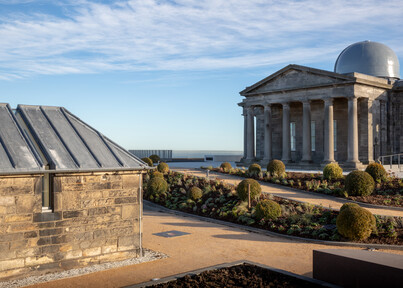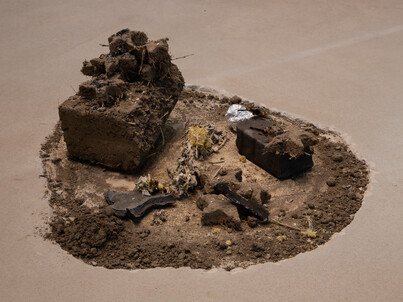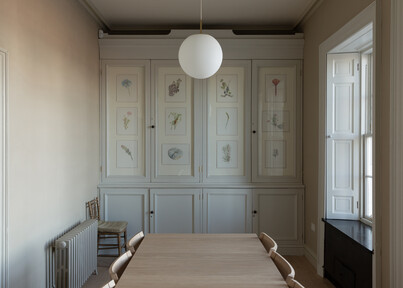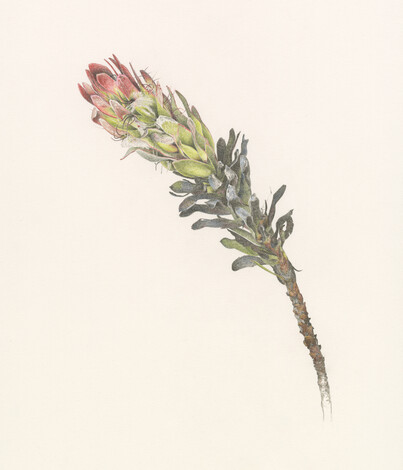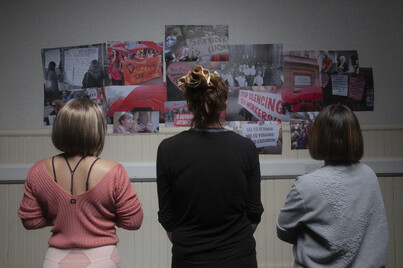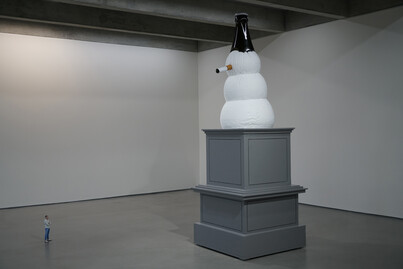Affinity and Allusion
by Dominic Paterson
Reviews /
Exhibition
• 29.01.2019
Thirty-four years into its history, and some five years after decamping from its modest Edinburgh street-front premises to the loftier site of Calton Hill, Collective has inaugurated its new suite of exhibition spaces with Affinity and Allusion, an ambitious, multi-faceted programme that takes in drawing, installation, sculpture, sound works, and off-site projects. Working in partnership with City of Edinburgh Council, and through the offices of Collective Architecture (no relation), Collective have transformed the disused observatory buildings already located at the crest of Calton Hill into exhibition, workshop and retail spaces FIG.1. Two newly constructed buildings house a further small gallery space and an outpost of esteemed restaurant The Gardener’s Cottage, respectively. The result is an expanded, multi-part ‘gallery’ quite unlike that occupied by any of Collective’s peers.
Elements of its inaugural programme have such subtly pitched affinities with, and make such carefully considered allusions to the site, that some account of Calton Hill’s history is essential. Collective's various architectural additions and adaptations neighbour ‘Edinburgh’s Disgrace’ (more officially named the National Monument), an unfinished Doric temple which might have vouchsafed the city’s claim to be ‘the Athens of the North’ had it not been left incomplete for lack of funds. Also adjacent is the Nelson Monument, an early nineteenth-century tower repurposed in 1852 as a timekeeping device visible to ships in the Firth of Forth. Such is the view from Calton Hill, with its comprehensive command of Edinburgh’s cityscape and its environs, that it was reportedly here that in 1787 the artist Robert Barker made the first of what he would name his ‘panorama’ paintings FIG.2. Collective’s site is already a constellation of histories, of national and civic projections, of attempts to survey the heavens, the landscape and the metropolis alike, and to organise time. This provides rich territory for contemporary artists to work on – especially for those attuned to the now-familiar conventions of site specificity – but what makes ‘Affinity and Allusion’ particularly interesting is how it comprises a set of constellations in its own right, mapping diverse approaches to art making today.
These approaches sometimes chart a course between astrological and astronomical ways of constructing a worldview. Dineo Seshee Bopape, a notable rising star, has made … [When Spirituality was a Baby] (to 10th February) for the circular City Dome gallery space FIG.3. The work gathers an astonishing array of materials, from obsidian, owl feathers and mammoth and dinosaur bones to granite, clay, charcoal and pyrite. A meteorite found in Argentina takes us beyond the earth; star anise, cast as shadows by an over-head projector, plays with the representation of the heavens. The effect is of a ritualistic, even alchemical deployment of substances, but the inclusion of soils taken from Congo, Nuremburg, Iceland, Palestine and from the artist’s birthplace, South Africa, bring us back to earth FIG.4. These materials bring questions of territory, land ownership and colonial appropriation emphatically to mind. Seen in this light, Bopape’s inscription of a series of marks (a variation of which forms an untranscribable part of the work’s title) into the gallery’s concrete floor suggests an assertive claiming of space. Magical and materialist thinking seem to co-exist within her work.
The printed text accompanying Bopape’s work renders her biography in her characteristic style, that is, as a kind of politically inflected astrological chart. It notes she was born in 1981, the same year ‘the Brixton Riots took place; two people were injured when a bomb exploded in a Durban shopping center; Bobby Sands died; MTV was launched; the Boeing 767 made its first flight; Umkonto we Sizwe performed numerous underground assaults against the Apartheid state’. We are left to wonder at the possible affinities between her life, work and contemporary events.
Questions of how meaning is made and articulated within the expanded space of an exhibition (including its textual supports) are central to James N. Hutchinson’s Rumours of a New Planet (to 31st March). Presented within the small library on the north side of the former observatory building FIG.5, Hutchinson’s work comprises three interrelated elements. The Manenburg Tornado is a group of twenty-six arrestingly accomplished botanical drawings FIG.6, based on a larger portfolio made by Margaret Stewart and her husband John Herschel (the polymath President of the Royal Astronomical Society) during their time in Cape Town in the 1830s. Hutchinson followed in their footsteps to find the flora growing in equivalent locations today, so that they become a portrait of the present through a map provided by the past. The drawings are not all exhibited concurrently but the selection is rotated throughout the run of the exhibition – a strategy in keeping with the artist’s creative use of curatorial interventions.
A comparable methodology animates his One Drop of Water Contains as Much Electricity as Would Make a Thunderstorm (2018), a drawing of a Michelangelo Pistoletto sculpture, accompanied by a collection of stones gathered as the artist re-enacted the 1852 journey from Dieppe to Florence made by Jessica Duncan (the wife of the Astronomer Royal for Scotland). Hutchinson’s encounter with various sites along the route as both geological resources and indices of change wrought by more than a century and a half of modernisation was further explored in a group of intelligent and precise essays by the artist, elegantly bound into a book that can be read in the library itself. Hutchinson’s third element is a contribution to a larger suite of ‘Observer’s Walks’ commissioned by Collective over their time at Calton Hill, including Catherine Payton’s Time Capsule (2018). Hutchinson’s Sightseers is an audio guide to the site, produced in collaboration with members of the Lothian Blind Ramblers and inspired by the important work done by visually impaired astronomers in the nineteenth century.
More recent historical allusions are made in Tessa Lynch’s Turns (ongoing). Extending her interest in the politics of public space, Lynch has constructed communal seating around Collective’s dispersed site. Its abstract forms are partly inspired by 1970s concrete playground designs in Craigmillar, a housing scheme that would become one of many around Edinburgh to suffer economic and social deprivation through the 1960s and beyond. Craigmillar’s playgrounds were the initiative of the Craigmillar Festival Society (1962–2002), which used art as vehicle for grass-roots agency. Lynch’s works fittingly insinuate that Collective might have deeper affinities with such social projects than with the decorous surroundings it now occupies. This is suggested too by Petra Bauer’s careful, considered collaboration with SCOT-PEP, a charity led by sex workers. The project, initiated in 2016, has yielded a film, Workers! FIG.7 which premiered in a screening shortly after Collective’s re-opening. During the discussion that followed, the radical Marxist feminist Silvia Federici lent her support to the film’s call for sex work to be recognised as work.
At the Hillside gallery, meanwhile, Klaus Weber made Fagman FIG.8, a droll proposal for what he terms a ‘nonument’ (24th November 2018 to 20th January 2019). Like Claes Oldenberg’s similarly witty proposals for outsized public sculpture, this smoking snowman with its broken beer bottle hat uses the vocabulary of quotidian life to satirise the pomposity and conservatism of its traditional counterparts, of which Calton Hill of course has some fine examples. A one-liner amid the slow-burn works featured elsewhere, Weber’s work brought irreverence and levity to Affinity and Allusion. It testified to the unpredictable, eclectic curatorial agendas at work here.
Collective understandably make much of the stellar context of their observatory home – their programmes bear names like ‘Satellites’ and ‘Constellations’, their (covetable) merchandise makes its own nods to stargazing too. Giorgio Agamben’s short, oft-cited text ‘What is the Contemporary?’ might help illuminate the deeper relevance of this particular allusion.1 In beholding the stars, Agamben tells us, we are viewing a collage of times, and the darkness within which the constellations appear to be set is afforded by the absence of light which is destined never to reach the earth from those galaxies accelerating away from us. Contemporariness, Agamben contends, is a way of seeing or registering this darkness: ‘the contemporary is the person who perceives the darkness of his time as something that concerns him, as something that never ceases to engage him’.2 Affinity and Allusion, as a manifestation of concern and engagement, might be understood along these lines. Much of what it says about our contemporary moment has to be discerned in facets which, if not exactly invisible, at least demand careful attention to be perceived: Hutchinson’s exploratory processes, Bauer’s commitment to collaboration and representation of political agency, Lynch’s sculptures-as-seating, hidden in plain sight, the audio guides that redescribe the site to their auditors. In making an elegant home for its subversive, experimental programme, Collective – led by its director Kate Gray – has intervened with the way Edinburgh sees itself and the way in which contemporary art is seen in the city. Collective looks better than ever, but there is more here than meets the eye.




